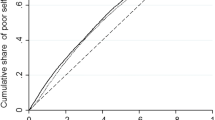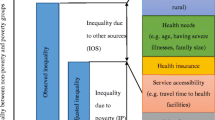Abstract
The study aims to investigate both income-related health inequality and horizontal equity in urban and rural China. The 4th and 5th National Health Services Survey, and extended samples in Shaanxi Province surveyed in 2008 and 2013, were analysed. Health outcome was measured using the EQ-5D-3L utility, scored by the Chinese-specific tariff. The concentration index was calculated to measure the degree of income-related health inequality and was further decomposed to study the strength of different contributing factors to explain health inequality. The horizontal inequity was further measured based on the decomposition results. The final study sample consists of 15,505 respondents in 2008 and 48,808 respondents in 2013. Descriptive analysis shows that compared to 2008, respondents in both urban and rural China reported worse HRQoL in 2013. There was a pro-rich inequality of HRQoL in both urban and rural China. Controlling for demographic factors, the pro-rich inequity of HRQoL remains. Economic and educational statuses are found to be two key factors explaining the pro-rich inequity. The establishment of basic medical insurance has shown a mixed effect on reducing health inequality. Strategies to reduce the inequality of residents’ economic and educational status, through further implementing the poverty reduction policies, should be prioritised by the local government.
Similar content being viewed by others
References
Anson, O., & Sun, S. (2004). Health inequalities in rural China: Evidence from HeBei Province. Health & Place, 10, 75–84.
Brazier, J. E., Ratcliffe, J., Salomon, J., & Tsuchiya, A. (2007). Measuring and valuing health benefits for economic evaluation. New York: Oxford University Press Inc.
Brazier, J. E., Yang, Y., Tsuchiya, A., & Rowen, D. L. (2010). A review of studies mapping (or cross walking) non-preference based measures of health to generic preference-based measures. European Journal of Health Economics, 11, 215–225.
Brixi, H., Mu, Y., Targa, B., & Hipgrave, D. (2013). Engaging sub-national governments in addressing health equities: Challenges and opportunities in China’s health system reform. Health Policy and Planning, 28, 809–824.
Cameron, A. C., & Trivedi, P. K. (2005). Microeconometrics: Methods and applications. New York: Cambridge University Press.
Chen, G., Inder, B., & Hollingsworth, B. (2014a). Health investment and economic output in regional China. Contemporary Economic Policy, 32, 261–274.
Chen, G., Liu, G. G., & Xu, F. (2014b). The impact of the Urban Resident Basic Medical Insurance on health services utilisation in China. Pharmacoeconomics, 32, 277–292.
Chen, L., Wu, Y., & Coyte, P. (2014c). Income-related children’s health inequality and health achievement in China. International Journal for Equity in Health, 13, 1–11.
Chen, G., & Yan, X. (2012). Demand for voluntary basic medical insurance in urban China: Panel evidence from the Urban Resident Basic Medical Insurance scheme. Health Policy and Planning, 27, 658–668.
Clemens, S., Begum, N., Harper, C., Whitty, J. A., & Scuffham, P. A. (2014). A comparison of EQ-5D-3L population norms in Queensland, Australia, estimated using utility value sets from Australia, the UK and USA. Quality of Life Research, 23, 2375–2381.
Collins, E., & Klein, R. (1980). Equity and the NHS: self-reported morbidity, access, and primary care. BMJ, 281, 1111–1115.
Commission on Social Determinants of Health. (2008). Closing the gap in a generation: Health equity through action on the social determinants of health. Final report of the commission on social determinants of health. Geneva: World Health Organization.
Coretti, S., Ruggeri, M., & McNamee, P. (2014). The minimum clinically important difference for EQ-5D index: A critical review. Expert Review of Pharmacoeconomics & Outcomes Research, 14, 221–233.
Diderichsen, F. (2004). Resource allocation for health equity: Issues and methods. Washington, DC: World Bank.
Ding, W., Lehrer, S., Rosenquist, N., & Audrain-McGovern, J. (2009). The impact of poor health on academic performance: New evidence using genetic markers. Journal of Health Economics, 28, 578–597.
EuroQol Group. (1990). EuroQol: A new facility for the measurement of health-related quality of life. Health Policy, 16, 199–208.
Fang, P., Dong, S., Xiao, J., Liu, C., Feng, X., & Wang, Y. (2010). Regional inequality in health and its determinants: Evidence from China. Health Policy, 94, 14–25.
Ghosh, J. (2010). Poverty reduction in China and India: Policy implications of recent trends. DESA Working Paper No. 92. United Nations Department of Economic and Social Affairs, New York.
Gundgaard, J., & Lauridsen, J. (2006). A decomposition of income-related health inequality applied to EQ-5D. European Journal of Health Economics, 7, 231–237.
Guo, Y., Shibuya, K., Cheng, G., Rao, K., Lee, L., & Tang, S. (2010). Tracking China’s health reform. Lancet, 375, 1056–1058.
Hinz, A., Klaiberg, A., Brahler, E., & Konig, H. H. (2006). The Quality of Life Questionnaire EQ-5D: modelling and norm values for the general population. Psychotherapie, Psychosomatik, Medizinische Psychologie, 56, 42–48.
Jin, H., Wang, B., Gao, Q., Chao, J., Wang, S., Tian, L., & Liu, P. (2012). Comparison between EQ-5D and SF-6D utility in rural residents of Jiangsu Province, China. PLoS One, 7, e41550.
Kakwani, N., Wagstaff, A., & Van Doorslaer, E. (1997). Socioeconomic inequalities in health: Measurement, computation, and statistical inference. Journal of Econometrics, 77, 87–103.
Lauridsen, J., Christiansen, T., Gundgaard, J., Hakkinen, U., & Sintonen, H. (2007). Decomposition of health inequality by determinants and dimensions. Health Economics, 16, 97–102.
Li, H., Wei, X., Ma, A., & Chung, R. (2014). Inequalities in health status among rural residents: EQ-5D findings from household survey China. International Journal for Equity in Health, 13, 41.
Liu, G. G., Dow, W. H., Fu, A. Z., Akin, J., & Lance, P. (2008). Income productivity in China: On the role of health. Journal of Health Economics, 27, 27–44.
Liu, G. G., Wu, H., Li, M., Gao, C., & Luo, N. (2014). Chinese time trade-off values for EQ-5D health states. Value in Health, 17, 597–604.
Lu, M. (2011). Poverty eradication in China: A new phase. United Nations. http://www.un.org/esa/socdev/csocd/2011/Lu.pdf. Accessed August 25, 2015.
McGrail, K. M., van Doorslaer, E., Ross, N. A., & Sanmartin, C. (2009). Income-related health inequalities in Canada and the United States: A decomposition analysis. American Journal of Public Health, 99, 1856–1863.
Meyer, D., & Sullivan, J. (2003). Measuring the well-being of the poor using income and consumption. Journal of Humam Resources, 38, S1180–S1220.
O’Donnell, O., van Doorslaer, E., Wagstaff, A., & Lindelow, M. (2008). Analyzing health equity using household survey data: A guide to techniques and their implementation. Washington, DC: The World Bank.
Perneger, T. V., Combescure, C., & Courvoisier, D. S. (2010). General population reference values for the French version of the EuroQol EQ-5D health utility instrument. Value in Health, 13, 631–635.
Richardson, J., McKie, J., & Bariola, E. (2014). Multi attribute utility instruments and their use. In A. J. Culyer (Ed.), Encyclopedia of health economics. San Diego: Elsevier Science.
Schwartzmann, L. (2009). Research and action: Toward good quality of life and equity in health. Expert Review of Pharmacoeconomics & Outcomes Research, 9, 143–147.
Sun, S., Chen, J., Johannesson, M., Kind, P., Xu, L., Zhang, Y., & Burstrom, K. (2011). Population health status in China: EQ-5D results, by age, sex and socio-economic status, from the National Health Services Survey 2008. Quality of Life Research, 20, 309–320.
Tan, Z., Liang, Y., Liu, S., Cao, W., Tu, H., Guo, L., & Xu, Y. (2013). Health-related quality of life as measured with EQ-5D among populations with and without specific chronic conditions: A population-based survey in Shaanxi Province, China. PLoS One, 8, e65958.
Tang, S., Meng, Q., Chen, L., Bekedam, H., Evans, T., & Whitehead, M. (2008). Tackling the challenges to health equity in China. Lancet, 372, 1493–1501.
van Doorslaer, E., Koolman, X., & Jones, A. (2004). Explaining income-related inequalities in doctor utilisation in Europe. Health Economics, 13, 629–647.
Wagstaff, A., van Doorslaer, E., & Watanabe, N. (2003). On decomposing the causes of health sector inequalities with an application to malnutrition inequalities in Vietnam. Journal of Econometrics, 112, 207–223.
Wang, H., Patrick, D., Edwards, T., Skalicky, A., Zeng, H., & Gu, W. (2012). Validation of the EQ-5D in a general population sample in urban China. Quality of Life Research, 21, 155–160.
Whitehead, M. (1992). The concept and principles of equity in health. International Journal of Health Services, 22, 429–445.
Yang, W., & Kanavos, P. (2012). The less healthy urban population: Income-related health inequality in China. BMC Public Health, 12, 804.
Yip, W., Hsiao, W. C., Chen, W., Hu, S., Ma, J., & Maynard, A. (2012). Early appraisal of China’s huge and complex health-care reforms. Lancet, 379, 833–842.
Yuan, Z., Han, B., Liao, X., Xiao, Y., & Hong, Y. (2010). Four-year follow-up surveying the influence of New Rural Cooperative Medical System on the equity of health output. Chinese Health Service Management, 27, 401–404. (in Chinese).
Zhang, L., Wang, J., Huang, F., Wu, S., Fang, Y., & Yan, X. (2014). Analysis on the relationship between the income level and the quality of life of rural residents in Shandong Province. Chinese Health Service Management, 1, 51–53. (in Chinese).
Zhou, Z., Gao, J., Fox, A., Rao, K., Xu, K., Xu, L., & Zhang, Y. (2011). Measuring the equity of inpatient utilization in Chinese rural areas. BMC Health Services Research, 11, 201.
Zhou, J., Ru, X., & Hearst, N. (2014a). Individual and household-level predictors of health related quality of life among middle-aged people in rural mid-east China: A cross-sectional study. BMC Public Health, 14, 660.
Zhou, Z., Zhu, L., Zhou, Z., Li, Z., Gao, J., & Chen, G. (2014b). The effects of China’s urban basic medical insurance schemes on the equity of health service utilisation: Evidence from Shaanxi province. International Journal for Equity in Health, 13, 23.
Acknowledgments
The authors are thankful to the Health Department of Shaanxi Province for providing data for analysis. This study is funded by the National Natural Science Foundation of China (Serial number: 71203177) and Shaanxi Social Science Fund (Serial number: 12Q036) is gratefully acknowledged.
Author information
Authors and Affiliations
Corresponding author
Ethics declarations
Conflict of interest
None declared.
Additional information
Zhongliang Zhou and Yu Fang are co-first authors.
Rights and permissions
About this article
Cite this article
Zhou, Z., Fang, Y., Zhou, Z. et al. Assessing Income-Related Health Inequality and Horizontal Inequity in China. Soc Indic Res 132, 241–256 (2017). https://doi.org/10.1007/s11205-015-1221-1
Accepted:
Published:
Issue Date:
DOI: https://doi.org/10.1007/s11205-015-1221-1




